 |
The Saint of the Day
St. James the Greater – July 25
Prof. Plinio Corrêa de Oliveira
Biographical selection:
St. James the Greater, Apostle, was the son of Zebedee and Salome, and brother of St. John the Evangelist. He was the first Apostle to receive the crown of martyrdom. Patron Saint of Spain, his name Santiago became a war cry in the fight against the Muslims.
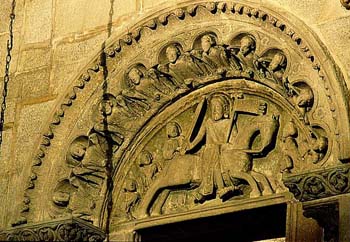
Santiago Matamoros, St. James the Moor-killer on the portal of the Cathedral of Compostela, Spain
|
Anne Catherine Emmerich had a vision of St. James, which she described in this way:
“From Jerusalem, St. James went to Sicily and then to Spain, stopping in Cadiz for a while. He was not well received, and was saved from being murdered by an Angel. He left Spain to seven disciples.
"Later he returned to Saragoza, where a large number of conversions took place. Even with this good result, the dangers abounded. Often the enemies would throw vipers on him, and he would calmly hold them in his hand without suffering any harm. In Granada he and all his disciples and the neophytes were put into prison. St. James implored the help of Our Lady, who lived in Jerusalem. By the hands of the Angels he was saved, and Our Lady commanded him to preach in Galicia.
“Later, I saw St. James in danger because of the persecution against the faithful in Saragoza. I saw the Apostle praying at night with some disciples near the walls of the city. He was asking for enlightenment to know if he should stay in that region or go elsewhere. He directed his thoughts to Most Holy Mary and asked her to intercede with her Divine Son, Who could not deny her anything.
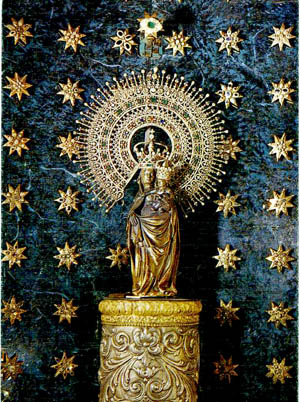
Virgen del Pilar in Zaragoza, Spain
|
“Suddenly, I saw a heavenly splendor come over the Apostle. Angels, singing harmoniously, carried down a column of light whose base they set on the place in which a church should be built. The column was tall and elegantly narrow, ending in the shape of an open lily which sent sparks of light in many directions. One of them went to Compostela. In the splendor of the lily I saw the Most Holy Mary, transparent and white like snow, with a delicacy and beauty greater than silk. She was standing as she used to pray. Her hands were joined, and a long veil on her head fell to her feet, which lightly touched the lily that shone with five rays of light. This vision of Our Lady was the origin of the devotion to Our Lady of the Pillar. (Virgen del Pilar)
“While the vision was taking place St. James received a message interiorly that he should build a church on that site, and that the devotion to Our Lady would be established there, take root, and expand. The Holy Virgin told him that once the church was built, he should return to Jerusalem. Indeed, later, when the work was completed, the Apostle left it in charge of twelve disciples he had formed and left.
“In Ephesus, he visited the Holy Virgin. Mary predicted his coming death, consoling and comforting him greatly. Then he said farewell to Our Lady and St. John, and left for Jerusalem. In that city he was taken by the Jews and brought to Mount Calvary. Along the way he continued to preach, converting and curing many. He was beheaded. Some time later, his body was brought to Spain.”
Comments of Prof. Plinio:
This selection covers so many beautiful and edifying elements that it does not permit me to make a complete commentary here.
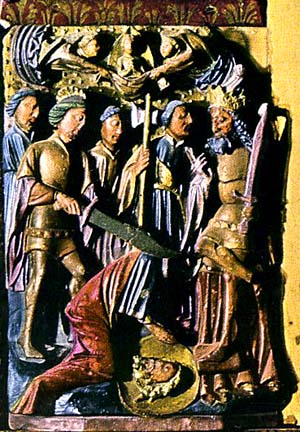
St. James was executed by sword in Jerusalem, the first Apostle martyred
|
An interesting note is to see in the lives of the Apostles and Saints, as well as in the life of Our Lord Jesus Christ, how God has marked an hour for everything. The enemies do all they can to kill the Apostle, but they are unable to do so. However, when the moment arrives that God has determined St. James should die, then nothing can save him. He is warned that he will die, and in fact, he becomes a martyr, his life is offered in a holocaust.
This is exactly what happened with Our Lord. His life might have been taken many times before he was taken in the Garden of Olives. He crossed the paths of his enemies many times without a single scratch and without one of them able to succeed in an agression against him. However, when His hour came according to the designs of Divine Providence, He delivered Himself to death. Any measure to save His life became futile.
The same thing happened with St. James. He passed through all types of danger, and every attempt to kill him did not succeed. However, at a certain moment he received from Our Lady the warning that his life would end. She comforted him, and then he actually died. The design of Divine Providence was accomplished.
The apparition to St. James in Spain is also very beautiful. There is a contrast in the column ending in the shape of a lily spreading light and fire. The lily is delicate, fresh and white like snow. The fire is orange or red, hot and burns everything. But here the lily is both snow-white and spreading fire. It has a flame that does not burn, but enlightens and imparts spiritual ardor. It would be an interesting work for a painter to imagine what color to use to express such a flame coming from this lily.
The lily atop the elegant column is symbolic of the Christendom about to be born in Catholic Spain. The column was a support for a lily full of light and fervor – the virginal Heart of Mary - spreading flames in all directions since Spain would be a foundation for the devotion to Our Lady. Those flames set afire the sky all the way to Compostela, where the devotion to the Virgen del Pilar and St. James would flourish in the Middle Ages.
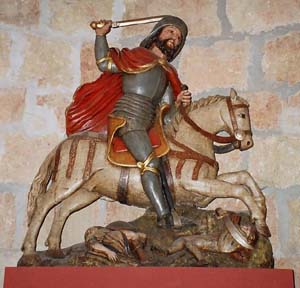
Another statue of Santiago Matamoros
|
You also know that Santiago, St. James, became a war cry during the Reconquista. The Spanish warriors used to charge the Moors shouting “Santiago, Santiago” and obtain victory through his intercession. This has a great beauty and represents a glorification of St. James. I do not know of a greater glory for a combative soul. A man dies and his memory remains, not as a sign of reconciliation, but as a war cry. At the moment when the warriors enter battle, risking everything for the Catholic cause, they have on their lips as a symbol of fight, force and victory, the name of Santiago. The last name that many would enthusiastically cry out before dying was the name of Santiago. They end the course of this life under the protection of St. James, receiving the smile of Mary as they present themselves for their judgment. I think that nothing can be more beautiful than this.
It clearly demonstrates the glory of a man’s name. The Church commemorates the special feast days of the Most Holy Name of Jesus and the Most Blessed Name of Mary. Here we also understand the glory of the name of St. James, who gave birth to Spain, the combative nation par excellence, the arm of Christendom. This nation burning with zeal was born from that blazing lily, and became a nation of fire. This nation chose the name of the Apostle who founded it as a war cry in the Reconquista. I can’t think of anything more beautiful than this.
Let us honor Our Lady for the glory she received from this great servant of hers, the Apostle St. James.

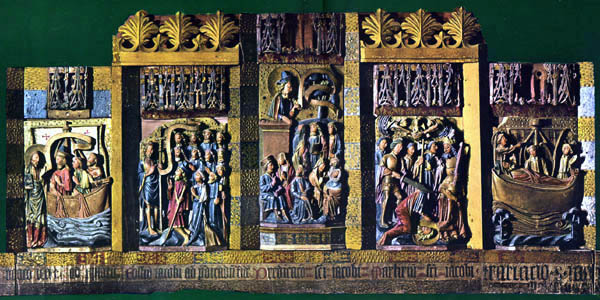
Panel with scenes from the life of St. James in the Cathedral of Santiago.
From left, Our Lord calls St. James; preaching in Spain; visiting Our Lady in Ephesus; his martyrdom; his body translated by boat to Compostela |

  | | Prof. Plinio Corrêa de Oliveira | |
The Saint of the Day features highlights from the lives of saints based on comments made by the late Prof. Plinio Corrêa de Oliveira. Following the example of St. John Bosco who used to make similar talks for the boys of his College, each evening it was Prof. Plinio’s custom to make a short commentary on the lives of the next day’s saint in a meeting for youth in order to encourage them in the practice of virtue and love for the Catholic Church. TIA thought that its readers could profit from these valuable commentaries.
The texts of both the biographical data and the comments come from personal notes taken by Atila S. Guimarães from 1964 to 1995. Given the fact that the source is a personal notebook, it is possible that at times the biographic notes transcribed here will not rigorously follow the original text read by Prof. Plinio. The commentaries have also been adapted and translated for TIA’s site.
|
Saint of the Day | Home | Books | CDs | Search | Contact Us | Donate

© 2002- Tradition in Action, Inc. All Rights Reserved
|
 |

|